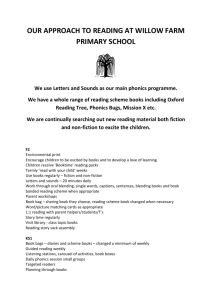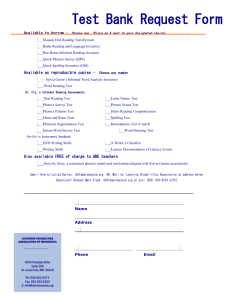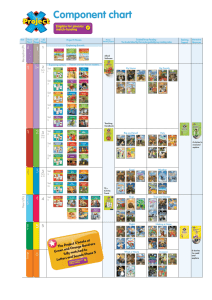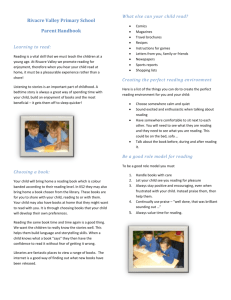Her PreK Wk 21_Ramsey - Veritas Classical Schools
advertisement
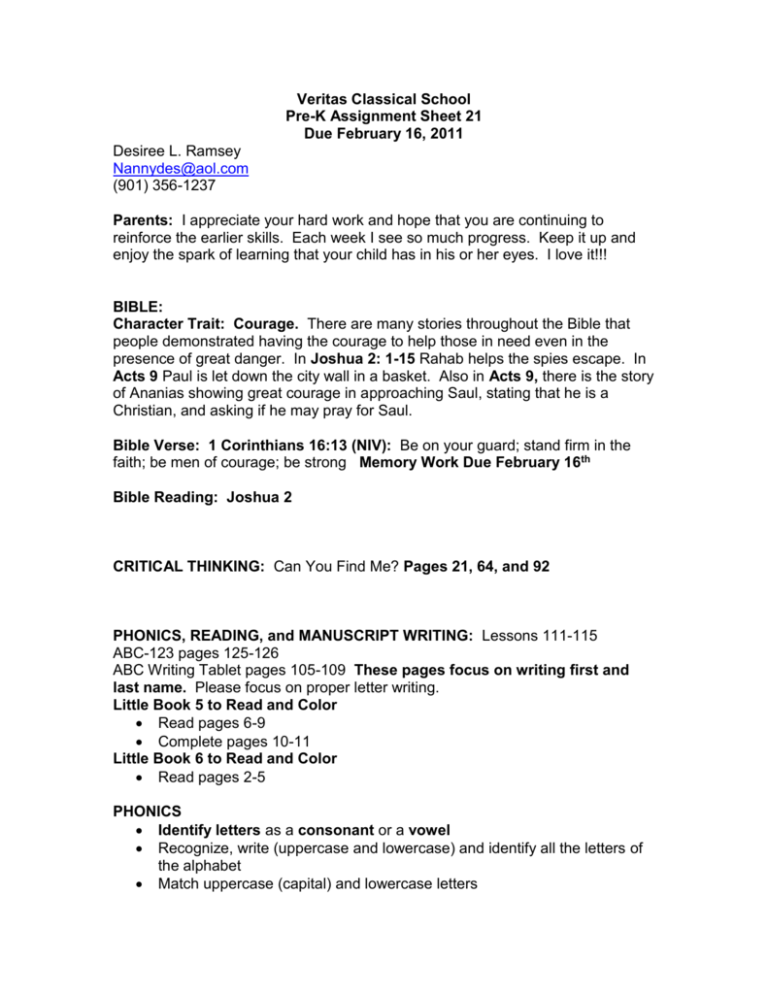
Veritas Classical School Pre-K Assignment Sheet 21 Due February 16, 2011 Desiree L. Ramsey Nannydes@aol.com (901) 356-1237 Parents: I appreciate your hard work and hope that you are continuing to reinforce the earlier skills. Each week I see so much progress. Keep it up and enjoy the spark of learning that your child has in his or her eyes. I love it!!! BIBLE: Character Trait: Courage. There are many stories throughout the Bible that people demonstrated having the courage to help those in need even in the presence of great danger. In Joshua 2: 1-15 Rahab helps the spies escape. In Acts 9 Paul is let down the city wall in a basket. Also in Acts 9, there is the story of Ananias showing great courage in approaching Saul, stating that he is a Christian, and asking if he may pray for Saul. Bible Verse: 1 Corinthians 16:13 (NIV): Be on your guard; stand firm in the faith; be men of courage; be strong Memory Work Due February 16th Bible Reading: Joshua 2 CRITICAL THINKING: Can You Find Me? Pages 21, 64, and 92 PHONICS, READING, and MANUSCRIPT WRITING: Lessons 111-115 ABC-123 pages 125-126 ABC Writing Tablet pages 105-109 These pages focus on writing first and last name. Please focus on proper letter writing. Little Book 5 to Read and Color Read pages 6-9 Complete pages 10-11 Little Book 6 to Read and Color Read pages 2-5 PHONICS Identify letters as a consonant or a vowel Recognize, write (uppercase and lowercase) and identify all the letters of the alphabet Match uppercase (capital) and lowercase letters Blend simple one syllable words using word families Begin to identify initial and final consonant sound in words PHONICS FOCUS: Review Short Vowels and One –Syllable Words Thursday: Using the Phonics Letter Cards and the Phonics Word Cards have your child cut out each letter and word carefully. Using the short u word cards only help your child create each word. Say each individual sound and let your child find the letter. After the word is complete show your child the word card. Continue with the rest of the short u cards. Friday: Using the Phonics Letter Cards and the rest of the Phonics Word Cards create the other words with your child as you did on Thursday and stress the short vowel sound in each word. Monday: Using all the Phonics Letter Cards and Word Cards create the words. Tuesday: Using the Phonics Word Cards ONLY have your child read the word cards. WORD FAMILIES: Review the word families that have been introduced. Read the words in each family and create a silly sentence using as many words as possible in that word family. Parents please do this daily and pick one word family sentence and write the sentence on paper. We will use these sentences in class as part of our reading time. WRITING PRACTICE: Manuscript Writing with Phonics pages 37-42 Designate 3 writing days. Complete 2 pages a day. All the letters except q and x have been introduced. Now is the time to be perfecting the formation of the letters. Please stress correct letter formation (top to bottom). This is the time that writing habits are being formed so please work diligently at teaching your child correct letter formation. Can you tell I am passionate about correct letter formation? Please continue to help your child with proper pencil technique and letter spacing. SENTENCE READING: Please practice reading the following sentences throughout your week: 1. Can you have fun with us at the zoo? 2. Do not yell in the shed. 3. The dog will lick my hand. 4. I will run to the top of the hill. 5. Will you pet the brown dog for me? ******Sentence Scramble***** Parents: Write each sentence on tablet paper. Keep the sentences separate. Cut each sentence into strips. Mix up the order but provide your child with the first word of the sentence. Remind your child that the first word of a sentence begins with a capital letter. Have your child read each word and put the words into a complete sentence. Remind your child to look for the . or the ? at the end of one of the words indicating the last word of the sentence. READING COMPREHENSION: Skill: Real or Fantasy (Make-Believe) Discuss the concept of real and fantasy with your child. Model how to determine what is real and what is fantasy. Example: I know that a car can go on the street. That is something we see everyday. We know that this is real. But can a car fly? I have never seen a car fly. This is not real; it is fantasy or makebelieve. We could make up a funny story about a flying car, but we know that it wouldn’t be a real story. It would be a make-believe story. Sometimes a story has things that are real and things that are make-believe or fantasy. Activity: Friday and Tuesday: Read a book to your child. Ask your child to tell you things that happened in the book that could be real and then ask for things that were fantasy or make-believe. Complete the Real and Make-Believe Worksheet. FIAR: Five In A Row: Follow the Drinking Gourd pages 142-148 Read the story daily. Please use the resource book and do as many activities as you can work into your schedule. Activities that are not mentioned will be done on Wednesdays. Activities: Social Studies: Geographic Directions; Language Arts: Theme Study; Art: Texture, Cut-Away View, Comparing Artist to Artist, Songs as a Teaching Method, Composition and Symbolism; Science: Signals, Star Groups and Constellations, Cotton. MATH: Lessons 111-115 ABC-123 pages 121 and 123 MATH FOCUS: Counting set to 15. Using goldfish make sets up to 15. Please make sure your child lines the goldfish up so he or she can count pointing and counting each fish. Do this activity several times throughout the week. Complete the Counting Worksheet Please remember to continue to focus on skills that you feel your child has not mastered to satisfactory: Time to the hour. 1. Continue to focus on time to the hour. Note that we say o’clock and it is written as :00. Using a brad fastener (sent home February 9th) make a paper clock. Practice time to the hour. Template provided Counting: 1 to 100 with your child consistently counting to 60. Count Backwards from 10. Recognizing and Order 1 to 15 1. Out of Order. Using flashcards 1 to 15 randomly pick three flashcards. Place the cards in any order. Ask your child to put the numbers in correct order. Write the numbers neatly and correctly. Repeat until all the numbers have been used. Write numbers 1 to 15 Determining ordinal positions “first through tenth” Creating models of sets of objects 11-15. Recognizing and write numbers to represent 11-15 Applying mathematical language by telling when a certain concepts are “too many,” “not enough,” “just right,” “more than,” “less than,” and “equal to.” Compare numbers 0 to 15. Have your child use the correct mathematical language. Top, Middle, Bottom Same or Different Larger and Smaller Which One Doesn’t Belong? Equal Parts Recognizing Coin Values Demonstrate an understanding of positional words (in, above, below, over, under, beside) Name the days of the week Name the months of the year Number Flashcards (Numbers 1 to 15) I found a math website that has a virtual or e-workbook for kindergarten. Try it out and let me know what you think. www.mathebook.net D.E.A.R: Drop Everything And Read 30 minutes daily including weekends: Your child should be able to read simple word family books to you. Try to incorporate your child reading to you during this time. SHARING: Read a book to your child. Divide a piece of paper into three sections. Label: First, Next, and Last. Without looking back have your child draw pictures to explain the book using the reminder words: first, next, and last. LIFE SKILLS: Teach your child to button, snap, zip, and tie. Perform simple two and three step tasks. Left and Right. Recite address and phone number. Make connections between self and text after shared reading. Initiate questions in conversation using age-appropriate words, phrases, and sentences. Demonstrate an understanding of a simple investigation by asking questions. Uses simple maps, globes and other three-dimensional models to identify and locate places. . SIGHT WORDS: Words: a, an, and, are, away, big, black, blue, brown, can, come, do, down, eight, five, for, four, from, go, green, has, have, here, I, in, into, is, it, like, little, look, love, me, nine, no, of, on, one, orange, pink, purple, red, run, said, see, seven, six, ten, the, they, three, to, two, was, we, what, when, white, who, yellow, you, zero, find, funny, help Jump on It: Use 5 to 10 flashcards per day. Spread out the flashcards and have your child jump on the word that is called out. Musical Cards: Place the flashcards in a circle. Play music. Have your child walk around the flashcards. Stop the music and have your child freeze. Have your child read the card that he or she is standing on. If the child reads the word correctly, he or she gets the point. If not, you get the point. Play to 10. In Homework Folder: _____ Best ABC Writing pages for the week _____Writing with Phonics pages 41 and 42 _____ Real and Make-Believe Worksheet _____ Counting Worksheet _____Silly Word Family Sentences Also Bring: _____ Lunch _____Snack _____ Sharing Item _____ Pencil Box with supplies if this item was brought home Parent Signature: ____________________________________________ February 16, 2011

